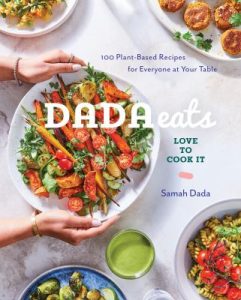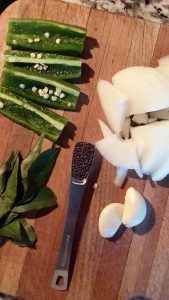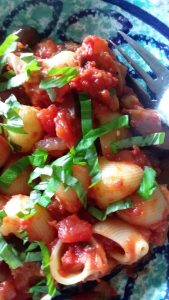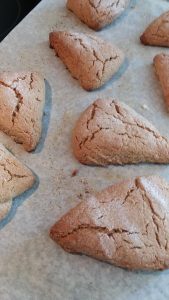Bibliobites in September: Legume Love, Tahini Trysts
October 18, 2022 Book Groups Library Staff
 We're back! After a summer hiatus, our Bibliobites group met, in person (!), on a sunny September morning. It was wonderful to welcome members new and old, and catch up with those we'd lost touch with over the past few years. And we were eager to discuss this month's title, Dada Eats Love to Cook It by blogger, TV star, and Instagram darling Samah Dada. The photogenic author has built a following among the many (her Instagram has 266,000 followers) who adore her particular mix of recipes: plant-ish, healthy-ish, and Indian-ish. Ms. Dada was new to us; and though we've been down both vegan and Indian roads before, what did we think of this author's version?
The book itself is the typical large format that seems to now be the standard; and there are lovely, appealing photos of most recipes. There are also many (too many for some) photos featuring the author, which seems to be especially prevalent in cookbooks produced by bloggers-- perhaps readers like to see an author they've come to know as a person as well as a cook. Hence the also-common practice of including personal essays and/or extensive headnotes. Some loathe this trend, others embrace it; but for now it's here to stay. One noticeable quirk of the photography: there are several photos highlighting the author's beautiful, perfectly manicured hands! The majority of recipes fit on one page, no mean feat when you consider that precious space is taken up by those longish headnotes. Though no one in the group complained about it, the print is tiny. That helps to get everything on one page, but does make for more squinting. Other general negatives: we wished overall recipe times had been stated up front; and directions were sometimes overly verbose.
On to the important part: what did we eat?? Ms. Dada's book covers breakfast, snacks, main dishes and desserts; but as usual most of us focused on the mains. There was lots of lentil and chickpea love going on; among the hits were the best dal ever, "really good, phenomenal!" Another dal, dal makhani, with black lentils and creamy coconut milk, was equally delicious.
We're back! After a summer hiatus, our Bibliobites group met, in person (!), on a sunny September morning. It was wonderful to welcome members new and old, and catch up with those we'd lost touch with over the past few years. And we were eager to discuss this month's title, Dada Eats Love to Cook It by blogger, TV star, and Instagram darling Samah Dada. The photogenic author has built a following among the many (her Instagram has 266,000 followers) who adore her particular mix of recipes: plant-ish, healthy-ish, and Indian-ish. Ms. Dada was new to us; and though we've been down both vegan and Indian roads before, what did we think of this author's version?
The book itself is the typical large format that seems to now be the standard; and there are lovely, appealing photos of most recipes. There are also many (too many for some) photos featuring the author, which seems to be especially prevalent in cookbooks produced by bloggers-- perhaps readers like to see an author they've come to know as a person as well as a cook. Hence the also-common practice of including personal essays and/or extensive headnotes. Some loathe this trend, others embrace it; but for now it's here to stay. One noticeable quirk of the photography: there are several photos highlighting the author's beautiful, perfectly manicured hands! The majority of recipes fit on one page, no mean feat when you consider that precious space is taken up by those longish headnotes. Though no one in the group complained about it, the print is tiny. That helps to get everything on one page, but does make for more squinting. Other general negatives: we wished overall recipe times had been stated up front; and directions were sometimes overly verbose.
On to the important part: what did we eat?? Ms. Dada's book covers breakfast, snacks, main dishes and desserts; but as usual most of us focused on the mains. There was lots of lentil and chickpea love going on; among the hits were the best dal ever, "really good, phenomenal!" Another dal, dal makhani, with black lentils and creamy coconut milk, was equally delicious.  Dal saag was a flavorful blend of lentils, tomatoes, and spinach accented by plenty of spice and lemon. Sesame crusted lentil falafel also hit the spot with its yummy lemon-tahini sauce, and "it looked just like the photo!" Two people tried the classic chana masala; one wasn't overly impressed, but for another it was "out of this world...such depth of flavors!" Chickpea patties were a tasty and fairly quick first cousin of falafel, with some nice crunch from their topping of fennel and cumin seeds.
From the pasta chapter, lentil bolognese was almost a favorite; our cook liked the concept but felt it needed tweaking. As in, it actually needed more lentils! But all in all this was a hearty complement for pasta that was quick and easy to make from standard pantry ingredients. Spaghetti aglio e olio 2.0 was also a riff on a classic pasta dish; this iteration included roasted cauliflower (our cook used broccoli) and kale. The roasted veggies added welcome depth, and the kale was a nice twist, too. On the downside, it "needed more salt," a problem easily corrected. Two pasta dishes highlighted eggplant: plot twist all' Arrabbiata and
Dal saag was a flavorful blend of lentils, tomatoes, and spinach accented by plenty of spice and lemon. Sesame crusted lentil falafel also hit the spot with its yummy lemon-tahini sauce, and "it looked just like the photo!" Two people tried the classic chana masala; one wasn't overly impressed, but for another it was "out of this world...such depth of flavors!" Chickpea patties were a tasty and fairly quick first cousin of falafel, with some nice crunch from their topping of fennel and cumin seeds.
From the pasta chapter, lentil bolognese was almost a favorite; our cook liked the concept but felt it needed tweaking. As in, it actually needed more lentils! But all in all this was a hearty complement for pasta that was quick and easy to make from standard pantry ingredients. Spaghetti aglio e olio 2.0 was also a riff on a classic pasta dish; this iteration included roasted cauliflower (our cook used broccoli) and kale. The roasted veggies added welcome depth, and the kale was a nice twist, too. On the downside, it "needed more salt," a problem easily corrected. Two pasta dishes highlighted eggplant: plot twist all' Arrabbiata and  the unforgettable spicy tomato pasta. These two were so similar that one could easily have been just a variation of the other. The eggplant is pureed for the Arrabbiata sauce, and thinly sliced for the spicy tomato pasta, but otherwise they were virtually identical in their components and flavor profile: spicy, tomato-y, and garlicky. Both were solid choices and easy to make. If you like your pasta in a salad, turmeric-tahini pasta salad was a keeper, with "lots of flavor!" The mix of spices perfectly complemented the pasta, chickpeas, and kale. Tahini dressing tied it all together.
Though veggies certainly are given their due in the main dishes, there's also a chapter devoted to salads, and one to vegetable sides. Hits included the crunchy creamy carrot salad (pictured on the book's cover), with sweet roasted carrots and spicy arugula; and chilled chaat masala chickpea salad, which was "refreshing! easy!" Turmeric- roasted cauliflower was a winner with its cool and creamy cilantro-tahini sauce, and turmeric provided appealing sunny yellow color to the normally pasty cauliflower. Kale and romaine za'atar caesar salad "wasn't really a caesar salad," though it was pleasing in its own way with "really good" croutons and za'atar-accented dressing. One definite flop: baingan bharta, a traditional Indian dish of stewed eggplant and tomato, which produced "mushy eggplant."
Since chickpeas were ubiquitous in this book, two people made pesto hummus. This was an easily made, garlicky spread that we enjoyed sampling at our meeting. In fact several group members noted that homemade hummus (of any variety) is very simple to make, and so much fresher than anything from a supermarket.
the unforgettable spicy tomato pasta. These two were so similar that one could easily have been just a variation of the other. The eggplant is pureed for the Arrabbiata sauce, and thinly sliced for the spicy tomato pasta, but otherwise they were virtually identical in their components and flavor profile: spicy, tomato-y, and garlicky. Both were solid choices and easy to make. If you like your pasta in a salad, turmeric-tahini pasta salad was a keeper, with "lots of flavor!" The mix of spices perfectly complemented the pasta, chickpeas, and kale. Tahini dressing tied it all together.
Though veggies certainly are given their due in the main dishes, there's also a chapter devoted to salads, and one to vegetable sides. Hits included the crunchy creamy carrot salad (pictured on the book's cover), with sweet roasted carrots and spicy arugula; and chilled chaat masala chickpea salad, which was "refreshing! easy!" Turmeric- roasted cauliflower was a winner with its cool and creamy cilantro-tahini sauce, and turmeric provided appealing sunny yellow color to the normally pasty cauliflower. Kale and romaine za'atar caesar salad "wasn't really a caesar salad," though it was pleasing in its own way with "really good" croutons and za'atar-accented dressing. One definite flop: baingan bharta, a traditional Indian dish of stewed eggplant and tomato, which produced "mushy eggplant."
Since chickpeas were ubiquitous in this book, two people made pesto hummus. This was an easily made, garlicky spread that we enjoyed sampling at our meeting. In fact several group members noted that homemade hummus (of any variety) is very simple to make, and so much fresher than anything from a supermarket.  Another delicious success was sweet potato aloo tiki. These were tasty little patties made from sweet potatoes, pan-fried and served with a slightly spicy yogurt sauce. The cool, creamy sauce was the perfect foil for the hot, crispy patties. Though this recipe was in the appetizer section, they made a fine dinner. One caveat: they didn't reheat all that well.
For the bakers in our group, there was plenty to choose from. Date caramel fudge brownies had a dense, gooey texture that was "really good!" The dates were a bit difficult to puree, but other than that the recipe was as quick as any other brownie recipe. Many of the baked goods in this book utilize coconut oil, and in these brownies the flavor was detectable-- so if you don't like coconut, you'll need to make a substitution. Salted peanut butter caramel bars made an appearance at our meeting; these were a rich layered treat of shortbread crust, peanut butter filling, and chocolate topping. We couldn't taste the coconut oil in these, perhaps because there were so many other yummy competing flavors! Pretzel tahini cookies were a satisfying, almost savory cookie. Almond flour made them soft and tender; pretzels added a nice crunch and a hit of salt. If you want to bake for breakfast, you could try rice crispy granola. This addictive blend featured lots of nuts, seeds, and almond butter. The addition of crispy rice cereal nicely lightened the mix. A second granola recipe, maple and olive oil tahini granola, didn't use the crispy rice cereal, but was otherwise so similar that it was essentially a variation of the first recipe. Either would be a welcome way to start the day.
Another delicious success was sweet potato aloo tiki. These were tasty little patties made from sweet potatoes, pan-fried and served with a slightly spicy yogurt sauce. The cool, creamy sauce was the perfect foil for the hot, crispy patties. Though this recipe was in the appetizer section, they made a fine dinner. One caveat: they didn't reheat all that well.
For the bakers in our group, there was plenty to choose from. Date caramel fudge brownies had a dense, gooey texture that was "really good!" The dates were a bit difficult to puree, but other than that the recipe was as quick as any other brownie recipe. Many of the baked goods in this book utilize coconut oil, and in these brownies the flavor was detectable-- so if you don't like coconut, you'll need to make a substitution. Salted peanut butter caramel bars made an appearance at our meeting; these were a rich layered treat of shortbread crust, peanut butter filling, and chocolate topping. We couldn't taste the coconut oil in these, perhaps because there were so many other yummy competing flavors! Pretzel tahini cookies were a satisfying, almost savory cookie. Almond flour made them soft and tender; pretzels added a nice crunch and a hit of salt. If you want to bake for breakfast, you could try rice crispy granola. This addictive blend featured lots of nuts, seeds, and almond butter. The addition of crispy rice cereal nicely lightened the mix. A second granola recipe, maple and olive oil tahini granola, didn't use the crispy rice cereal, but was otherwise so similar that it was essentially a variation of the first recipe. Either would be a welcome way to start the day.  Honey tahini scones were perfectly flavored with their namesake ingredients, but they suffered texturally from using only oat flour, which made them very crumbly and gave them a pasty mouthfeel. Still, they were good enough that, "I will try again."
This title has a pretty well-defined flavor profile (lots of cumin, turmeric, cilantro, cayenne), and some ingredients are used repeatedly (chickpeas, lentils, tahini-- I think I went through an entire jar of tahini in the month we used this book). Those were limiting factors for some. We certainly enjoyed many of the author's vegetable-centric combinations, and it was fun (if somewhat expensive) to experiment with non-wheat flours and various sweeteners. But, the narrow-ish range of flavors made for a book we'd use less often than others. So despite our successes, our rating reflected a bit of ambivalence; we averaged out to a 2.9 (out of a possible 5).
Our next meeting will be on October 28 at 11 AM in the Fireplace Room. We'll be discussing local restauranteur Barbara Lynch's memoir, Out of Line. If you want to try your hand at some of Ms. Lynch's iconic dishes, you can also pick up a copy of her one cookbook, Stir. Both are available at the main circulation desk or via curbside pickup. See you then!
Honey tahini scones were perfectly flavored with their namesake ingredients, but they suffered texturally from using only oat flour, which made them very crumbly and gave them a pasty mouthfeel. Still, they were good enough that, "I will try again."
This title has a pretty well-defined flavor profile (lots of cumin, turmeric, cilantro, cayenne), and some ingredients are used repeatedly (chickpeas, lentils, tahini-- I think I went through an entire jar of tahini in the month we used this book). Those were limiting factors for some. We certainly enjoyed many of the author's vegetable-centric combinations, and it was fun (if somewhat expensive) to experiment with non-wheat flours and various sweeteners. But, the narrow-ish range of flavors made for a book we'd use less often than others. So despite our successes, our rating reflected a bit of ambivalence; we averaged out to a 2.9 (out of a possible 5).
Our next meeting will be on October 28 at 11 AM in the Fireplace Room. We'll be discussing local restauranteur Barbara Lynch's memoir, Out of Line. If you want to try your hand at some of Ms. Lynch's iconic dishes, you can also pick up a copy of her one cookbook, Stir. Both are available at the main circulation desk or via curbside pickup. See you then!

